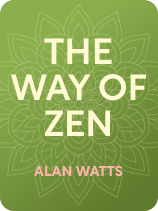

This article is an excerpt from the Shortform book guide to "The Way of Zen" by Alan Watts. Shortform has the world's best summaries and analyses of books you should be reading.
Like this article? Sign up for a free trial here.
Is it possible to know something without describing it with words? What’s the difference between acting impulsively and acting spontaneously?
Two Taoist philosophies helped give Zen Buddhism its form: There are two ways of knowing, and we can act spontaneously and naturally. Alan Watts discusses the influence of Taoism on Zen in his classic work The Way of Zen.
Read more to learn about the connection between Taoism and Zen Buddhism.
Taoism and Zen
Zen and its ideas can be traced back to three schools of thought: Taoism, Confucianism, and Mahayana Buddhism. Taoism and Confucianism are Chinese forms of thought and religion, while Mahayana Buddhism is an Indian school of Buddhism. Each contributed ideas that would become foundational to Zen Buddhist teachings about life and enlightenment. Let’s examine the links between Taoism and Zen.
Taoism proposes what Watts calls a liberation from Confucianism. Whereas Confucianism emphasizes the importance of ethics and social conventions, Taoism aims to help people see those conventions for what they are: socially agreed-upon meanings and values rather than something real or concrete. Taoism proposes that realizing the true nature of these conventions enables us to step back from them and experience life in harmony with the universe as it actually exists.
(Shortform note: Taoism is concerned with the limitations that you impose on yourself in the physical, psychological, and spiritual spheres of your life, as when you follow a belief system like Confucianism. By encouraging you to question the ideas that you’ve learned from society, Taoism seeks to help you transcend your limitations and live in accordance with the true nature of reality, acting only in ways that are in keeping with the Tao. A key aspect of Taoism—one shared by Zen Buddhism—is that it proposes that the highest truth, or the Tao, can’t be expressed in words or understood through logical thought. Words are just symbols for the things they represent, and enlightenment happens beyond the bounds of description and definition.)
Two ideas of Taoism became foundational to Zen Buddhism: the idea that we can experience two different kinds of knowledge and the idea that we can act spontaneously in the moment.
There Are Two Ways of Knowing
First, the Taoist idea that there are two kinds of knowledge—conventional and unconventional—deeply influenced Zen. Conventional knowledge is contingent on socially agreed-upon meanings and value judgments. Watts writes that these are culturally defined and have to be represented in language (or other forms of notation, like mathematical equations). Facts, labels, and definitions are conventional knowledge. For instance, you use conventional knowledge when you walk down the street and notice that you’re walking under “trees”; that one is an “oak” and another a “planetree,” and both belong to a category of organisms called “plants.”
On the other hand, unconventional knowledge doesn’t rely on the abstractions of language and representation. Instead, it gets directly at the experience of the actual world. When you’re walking under an oak tree, you might feel its shade, take in the scent of its leaves, and watch the movement of its branches. Your experience of observing it without naming or describing it is unconventional knowledge. We often assume that we can’t “know” something unless we can express it in language. But Taoism proposes that unconventional knowledge enables us to know the world directly, by experiencing it.
(Shortform note: The distinction between conventional knowledge and unconventional knowledge is relevant beyond the borders of Zen. Philosopher Jay Garfield identifies the relationship between ordinary reality (conventional knowledge) and ultimate reality (unconventional knowledge) as a question with relevance in all schools of Buddhism. Questions about whether the two are the same or different, and whether the world is illusory or real, arise everywhere. In Indian Buddhism, the “theory of two truths” maintains that there is a “truth of mundane conventions” that fits within our conventional linguistic and conceptual frameworks and a “truth of the ultimate” beyond the limits of those frameworks.)
We Can Act Spontaneously and Naturally
Another idea that’s foundational to Zen comes from the Taoist principle wu-wei, the experience of making decisions naturally and spontaneously. Watts writes that, when you let your mind decide how to act, it moves more naturally and intelligently—not impulsively, but out of the spontaneity of the moment. This leads to the experience of wu-hsin, translated as “no mind,” a kind of “un-self-consciousness” that you can experience when you let your mind work without trying to direct it or interfere with it. You can develop te, or “virtue,” a creative ability that you can only access by acting naturally and spontaneously.
Watts traces this logic a step further and explains that not only can you act spontaneously, but there’s no other way you can behave. If you realize that even your intentions, purposeful actions, and voluntary decisions arise spontaneously from your natural self (the self that you actually experience, rather than the abstract idea of yourself), then you can stop trying to be spontaneous or worrying that you aren’t.
(Shortform note: Experiencing wu-wei and wu-hsin are key parts of the Taoist goal of living in harmony with the universe. The Tao Te Ching teaches that while we make things out of tangible material, what we often use in our daily lives is intangible space, such as the empty space inside a house. To create a similar kind of emptiness in your life, you have to embrace wu-wei, which involves letting go of your personal desires and acting only when the time is right. That’s when we can experience wu-hsin and act naturally and unselfconsciously.)

———End of Preview———
Like what you just read? Read the rest of the world's best book summary and analysis of Alan Watts's "The Way of Zen" at Shortform.
Here's what you'll find in our full The Way of Zen summary:
- The major principles and history of Zen Buddhism
- How to experience Zen in everyday life—without a strict meditation practice
- Why calling Zen a "practice" is a mistake






